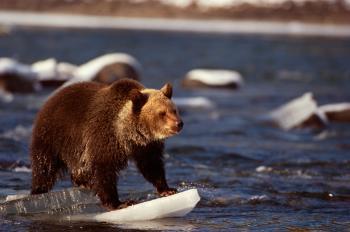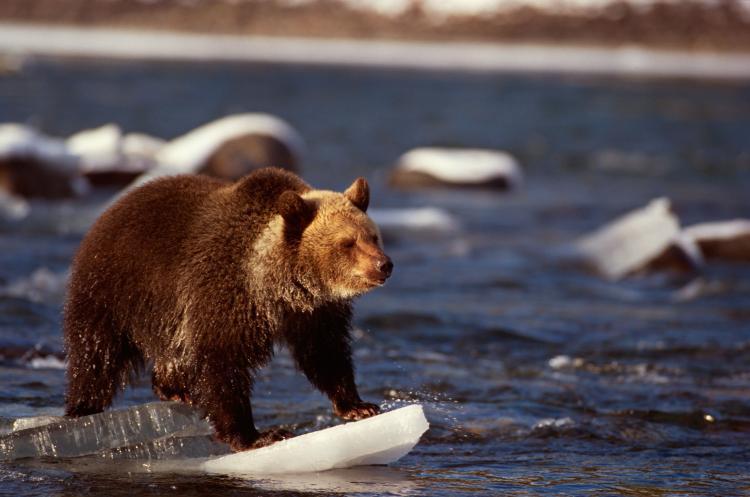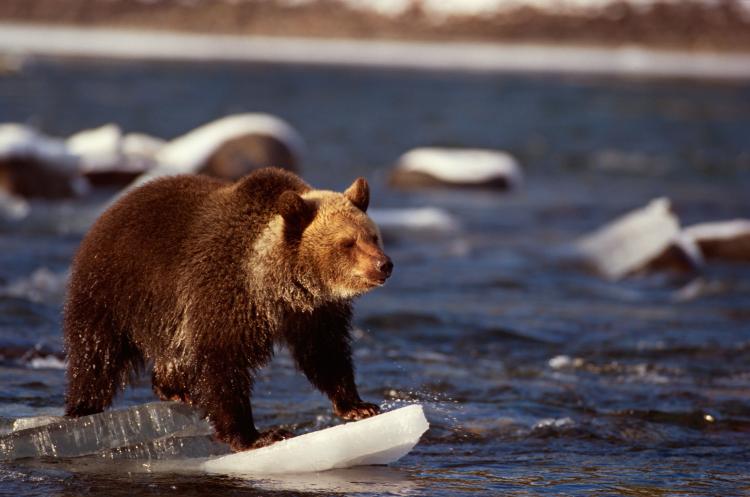EDMONTON—The primary way to recover Alberta’s declining grizzly bear populations is to minimize contact between people and bears by limiting the number of roads in grizzly-bear habitat, says a new report.
Released last Friday by a coalition of conservation groups, the report said the outlook for Alberta’s grizzlies “under current conditions is a 98.6 per cent risk of population decline by 30 per cent or more over the next 36 years.”
Titled A Grizzly Challenge, the report was released the same week a grizzly sow was killed after being hit by a train in Banff National Park and another sow was illegally shot and later put down near Cardston.
Sarah Elmeligi, senior conservation planner with the Canadian Parks and Wilderness Society, one of the sponsors of the report, says the report showcases where the government has fallen short on grizzly bear recovery.
“The ultimate goal of a report like this is to motivate the government to fully implement the Grizzly Bear Recovery Action [Plan] in the province,” says Elmeligi, noting that the plan itself falls short of recovering grizzly populations to their fullest potential.
Recommendations of the Alberta Grizzly Bear Recovery Action Plan, which was adopted by the province in 2008, include suspending the grizzly bear hunt, gathering and conducting scientific data, and public education, among others.
The coalition’s report also recommends implementing strong government legislation, showing that this approach has had success south of the border.
“We like to see improvements in legislation associated with roads in particular,” says Elmeligi. “Roads are being constructed for resource extraction purposes in grizzly bear habitat, so we’d like to see legislation associated with roads being removed or reclaimed once the resource extraction purpose is completed.”
A 2010 report published by the province puts the current grizzly count in both provincial and federal lands at 760. The province’s Endangered Species Conservation Committee has recommended that grizzlies be listed as a threatened species. So far, this has not been approved by Alberta’s minister of sustainable resource development Mel Knight.
Dave Ealey, a spokesperson for Alberta Sustainable Resource Development, says Knight is consulting with colleagues on the issue.
He says that since a major aspect of wildlife management is about managing people, the government is trying to understand all the concerns Albertans may have before a decision is made.
For example, he says some Albertans have talked to the ministry about whether they'd be safe in the back country if the grizzly bear are listed as threatened species, or what the implications would be in certain areas with industry operations.
Even if grizzlies are designated as a threatened species, Ealey says he doesn’t anticipate there would be much change from what the government is currently doing as it is already following the recovery plan.
“The Recovery Plan is pretty comprehensive, and it addresses virtually all of the objectives of a good recovery plan; it took a long time to build,” he says.
Dr. Scott Nielsen, an assistant professor of conservation biology at the University of Alberta, says one reason the government is hesitant to list grizzlies as threatened could be that it would place additional pressure on access management. This would limit road development and hence reduce access for energy and fibre resource extraction, and further result in the full suspension of hunting until populations are considered recovered.
“Although everyone is looking to science for a solution, science can only provide guidance and information for decision-making. When this information aligns with public and political sentiment, all is well. When it suggests otherwise, you have the situation we are currently in,” Nielsen says.
However, he agrees that the recovery plan can be implemented without a change in status for the bears.
“In fact, in an ideal world, it would be best to implement recovery plans for species before they are listed as threatened or endangered to avoid the problems associated with trying to rescue a species right before its funeral.”
Nielson explains that Alberta has low habitat productivity due to its cool, continental climates with short growing season, no access to salmon, and a relatively poor production of fruit compared to British Columbia and Montana, all of which contribute to limit the size of grizzly bear populations. This is particularly problematic as small populations are more vulnerable to population decline, so recovery will be slow.
“Because our populations are small and due to the fact that the species naturally has low reproductive rates (even lower in Alberta), the species is especially sensitive to human-caused mortalities that result from increased access of habitats that were previously inaccessible,” he says.
The “pioneering phase of resource management” in Alberta, combined with the negative attitudes of a small percentage of Albertans toward grizzly bears, presents a serious management challenge for the bears.
“In the long-term, it will take education and a new generation of folks focused on stewardship … to make roads a non-issue,” Nielson says.
He notes that Scandinavia went through the same cycle. A century ago, their brown (grizzly) bear population dropped to 500. Today it exceeds 3,000, with no reduction in the number of roads.
“The difference is that they are no longer using the same pioneering attitudes that they once had and that we still favour here.”
Nielson agrees with the report’s conclusion that the government needs to do more to recover the grizzly populations. A good place to start, he says, is by “implementing the recovery team recommendations and the Endangered Species Conservation Committee recommendations that the species be listed as threatened.”
Ealey says the department of Sustainable Resource Development is currently reviewing the report.
Released last Friday by a coalition of conservation groups, the report said the outlook for Alberta’s grizzlies “under current conditions is a 98.6 per cent risk of population decline by 30 per cent or more over the next 36 years.”
Titled A Grizzly Challenge, the report was released the same week a grizzly sow was killed after being hit by a train in Banff National Park and another sow was illegally shot and later put down near Cardston.
Sarah Elmeligi, senior conservation planner with the Canadian Parks and Wilderness Society, one of the sponsors of the report, says the report showcases where the government has fallen short on grizzly bear recovery.
“The ultimate goal of a report like this is to motivate the government to fully implement the Grizzly Bear Recovery Action [Plan] in the province,” says Elmeligi, noting that the plan itself falls short of recovering grizzly populations to their fullest potential.
Recommendations of the Alberta Grizzly Bear Recovery Action Plan, which was adopted by the province in 2008, include suspending the grizzly bear hunt, gathering and conducting scientific data, and public education, among others.
The coalition’s report also recommends implementing strong government legislation, showing that this approach has had success south of the border.
“We like to see improvements in legislation associated with roads in particular,” says Elmeligi. “Roads are being constructed for resource extraction purposes in grizzly bear habitat, so we’d like to see legislation associated with roads being removed or reclaimed once the resource extraction purpose is completed.”
A 2010 report published by the province puts the current grizzly count in both provincial and federal lands at 760. The province’s Endangered Species Conservation Committee has recommended that grizzlies be listed as a threatened species. So far, this has not been approved by Alberta’s minister of sustainable resource development Mel Knight.
Dave Ealey, a spokesperson for Alberta Sustainable Resource Development, says Knight is consulting with colleagues on the issue.
He says that since a major aspect of wildlife management is about managing people, the government is trying to understand all the concerns Albertans may have before a decision is made.
For example, he says some Albertans have talked to the ministry about whether they'd be safe in the back country if the grizzly bear are listed as threatened species, or what the implications would be in certain areas with industry operations.
Even if grizzlies are designated as a threatened species, Ealey says he doesn’t anticipate there would be much change from what the government is currently doing as it is already following the recovery plan.
“The Recovery Plan is pretty comprehensive, and it addresses virtually all of the objectives of a good recovery plan; it took a long time to build,” he says.
Small Populations More Vulnerable
Dr. Scott Nielsen, an assistant professor of conservation biology at the University of Alberta, says one reason the government is hesitant to list grizzlies as threatened could be that it would place additional pressure on access management. This would limit road development and hence reduce access for energy and fibre resource extraction, and further result in the full suspension of hunting until populations are considered recovered.
“Although everyone is looking to science for a solution, science can only provide guidance and information for decision-making. When this information aligns with public and political sentiment, all is well. When it suggests otherwise, you have the situation we are currently in,” Nielsen says.
However, he agrees that the recovery plan can be implemented without a change in status for the bears.
“In fact, in an ideal world, it would be best to implement recovery plans for species before they are listed as threatened or endangered to avoid the problems associated with trying to rescue a species right before its funeral.”
Nielson explains that Alberta has low habitat productivity due to its cool, continental climates with short growing season, no access to salmon, and a relatively poor production of fruit compared to British Columbia and Montana, all of which contribute to limit the size of grizzly bear populations. This is particularly problematic as small populations are more vulnerable to population decline, so recovery will be slow.
“Because our populations are small and due to the fact that the species naturally has low reproductive rates (even lower in Alberta), the species is especially sensitive to human-caused mortalities that result from increased access of habitats that were previously inaccessible,” he says.
The “pioneering phase of resource management” in Alberta, combined with the negative attitudes of a small percentage of Albertans toward grizzly bears, presents a serious management challenge for the bears.
“In the long-term, it will take education and a new generation of folks focused on stewardship … to make roads a non-issue,” Nielson says.
He notes that Scandinavia went through the same cycle. A century ago, their brown (grizzly) bear population dropped to 500. Today it exceeds 3,000, with no reduction in the number of roads.
“The difference is that they are no longer using the same pioneering attitudes that they once had and that we still favour here.”
Nielson agrees with the report’s conclusion that the government needs to do more to recover the grizzly populations. A good place to start, he says, is by “implementing the recovery team recommendations and the Endangered Species Conservation Committee recommendations that the species be listed as threatened.”
Ealey says the department of Sustainable Resource Development is currently reviewing the report.








Friends Read Free